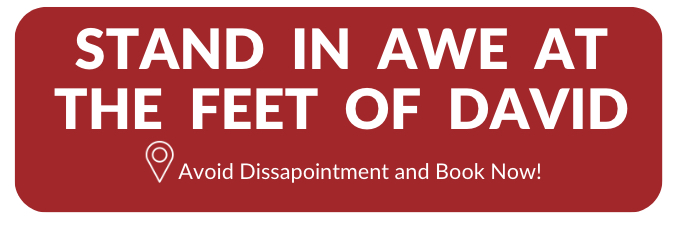The history of the Renaissance in Florence is synonymous with one figure above all others: Michelangelo Buonarotti. Over the course of his incredibly long life, Michelangelo left behind a string of extraordinary masterpieces in painting, sculpture and architecture that changed the story of art forever. And there’s nowhere better to see the best of Michelangelo’s art than Florence, his home town and site of many of his greatest triumphs.
As an art historian of the Renaissance, I have spent countless happy hours gazing on Michelangelo’s masterpieces in the city - from the most famous works like the David to lesser known - but no less impressive - works like the moving Pieta that the aged sculptor intended to adorn his own tomb.
To help you follow in Michelangelo’s footsteps on your own trip to Florence, I’ve put together this guide to 10 places where you can see Michelangelo’s art in the city. Enjoy!
1. The Accademia Gallery

Nowhere houses more sculptures by Michelangelo than Florence’s Accademia Gallery. The big-daddy of the collection is - yes, you guessed it - Michelangelo’s masterful David, a towering work depicting the plucky shepherd-boy who downed the brutish Goliath and became one of Israel’s greatest kings.
Michelangelo was only 26 when he carved the David from a block of marble considered unusable by his contemporaries, fashioning an icon of Florence and cementing his status as the world’s most important artist in the process.
Also in the Accademia are Michelangelo’s Prisoners or Slaves, struggling figures who were intended to form part of the massive tomb that the sculptor was commissioned to create for Pope Julius II in St. Peter’s Basilica.
In their inchoate, unfinished state they represent a theme common in Michelangelo’s work - the philosophy of the non finito, or unfinished. For more on what you need to see in the Accademia, see our separate article here.
2. The Uffizi Gallery
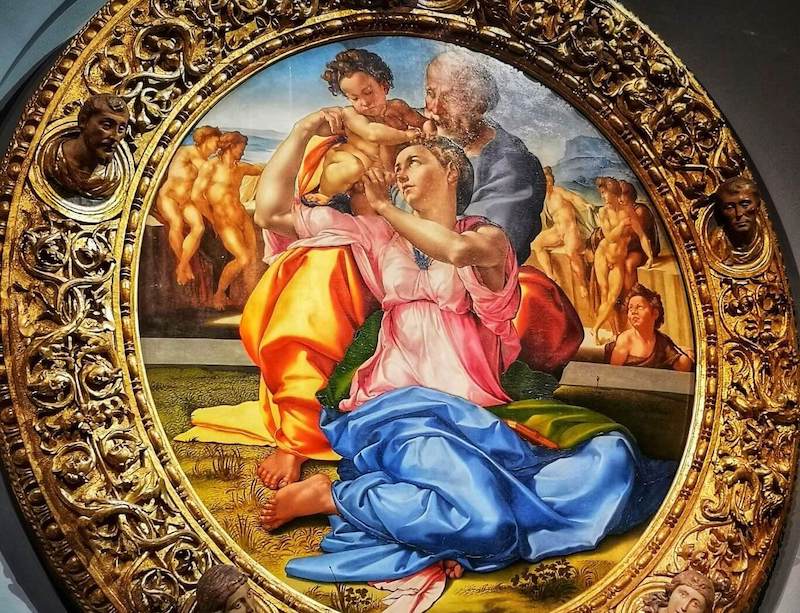
Michelangelo was much more than just a sculptor. As the archetypal Renaissance man, he was highly proficient at all the various visual arts, including painting. The Uffizi Gallery is Florence’s most important art gallery, and it’s here where you’ll see what is arguably Michelangelo’s most important panel painting: The Doni Tondo.
The painting was commissioned by the wealthy Agnolo Doni to celebrate his marriage to Maddalena Strozzi, heiress to one of the most powerful families in Florence. Depicting the Holy Family ensconced in a blissful embrace, it seems to reflect Agnolo’s hopes for a happy home life in the Doni household in the years to come.
In its striking use of bright primary colours and unexpectedly muscular, even sculptural figures, the Doni Tondo provides a tantalising glimpse into the developing painterly aesthetic of Michelangelo that would reach its fullest expression on the Sistine Chapel ceiling a few years later. For art lovers, visiting the Uffizi is a must in Florence. To explore the gallery in the company of a local expert, click the link below!
3. The Medici Chapel (New Sacristy) in San Lorenzo
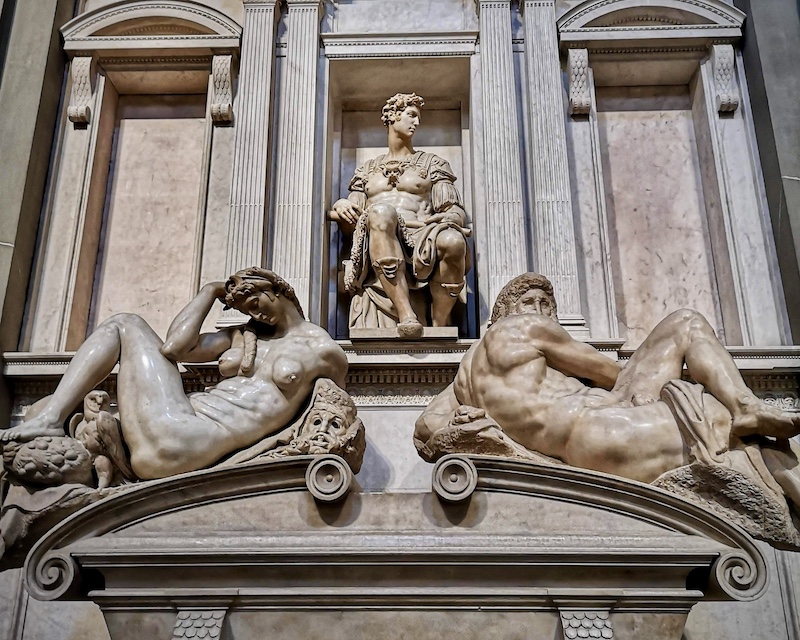
Michelangelo’s relationship with the all-powerful Medici family was a fraught one. Although the artist had strong republican inclinations, the Medici remained his most important patrons for much of his career. The most significant - and personal - commission he received from them was for a family funeral chapel in the church of San Lorenzo, which he laboured on during the 1520s.
Michelangelo meticulously planned every detail of the New Sacristy, as the chapel is called, from the architecture to the decorations and monuments. At the heart of the scheme are two incredible tombs dedicated to two newly deceased Medici Dukes, Lorenzo and Giuliano, known as the Capitani. Initially another tomb was planned here for Michelangelo’s mentor Lorenzo the Magnificent and his brother Giuliano, the so-called Magnifici, but this was never completed.
The Capitani tombs are magnificent: at the centre of each are the Dukes, kitted out in ancient armour and looking for all the world like Roman emperors. Beneath, reclining on their sarcophagi, are two pairs of allegorical figures.
On Giuliano’s are the famous personifications of Night and Day, while Lorenzo’s coffin lid is surmounted by Dusk and Dawn. In these profound mediations of the nature of life and death, Michelangelo once again elevated the art of sculpture into the realms of philosophy.
4. Palazzo Vecchio
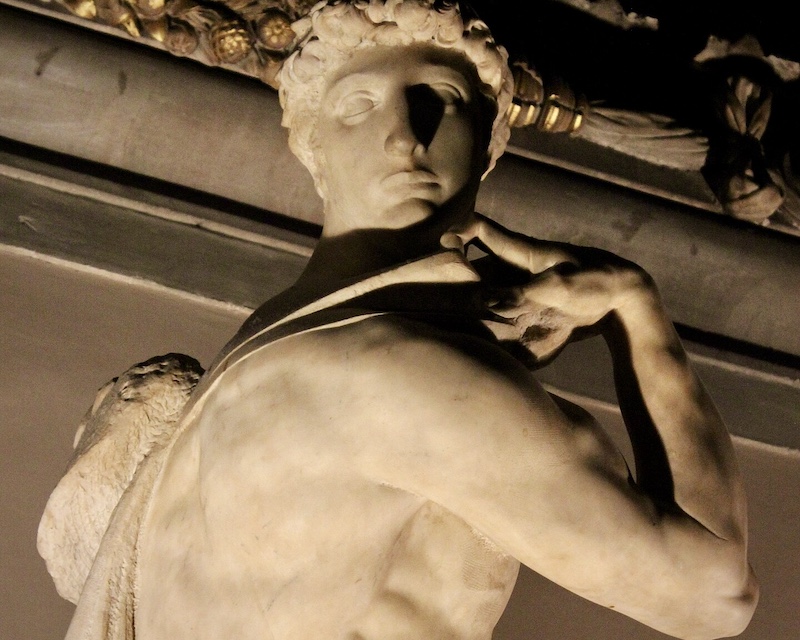
Photo Miguel Hermoso Cuesta, wikimedia commons, CC BY-SA 4.0
Dominating Piazza della Signoria, the Palazzo Vecchio was home to Florence’s magistrates during the Renaissance before becoming the private home of the Medici as the family tightened their stranglehold on the city in the 16th century. Today the palace is one of the best museums in Florence, and houses another Michelangelo gem: The Genius of Victory.
In Michelangelo’s final spell in Florence in the late 1530s, the great artist came up with another of the many sculptures that he intended to use for the late Pope Julius II’s tomb in Rome. A noble male, representing the concept of victory, nude kneels in spiralling contrapposto over an elderly vanquished victim.
The twisting, serpentine figure showcases Michelangelo’s skills at composition at their best. Take a look at the elegant face of Victory to get a close-up look at the sculptor’s amazing carving skills: as the stone has been left unpolished, you can see the intricate network of furrowed left by the chisel, transforming before our eyes into an image of almost miraculous beauty.
5. The Museo dell’Opera del Duomo
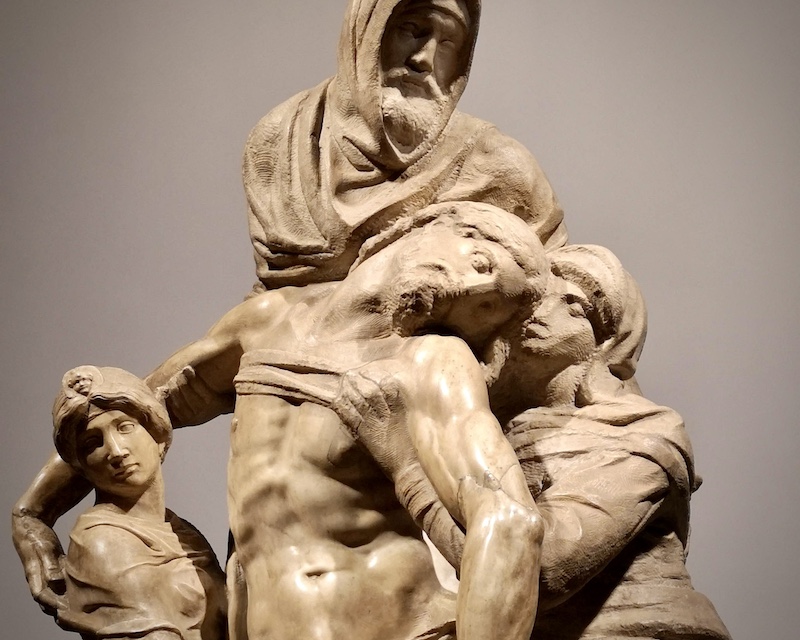
Just around the corner from Florence cathedral, the Museo dell’Opera del Duomo is one of Florence’s most underrated museums. Amongst the numerous highlights on show here, the museum houses one of the final - and arguably most powerful - works of Michelangelo's career. In it, the artist returned to one of his favourite themes: the Pietà.
If you have visited Rome you are probably familiar with Michelangelo’s most famous version of the subject, which you can see in St. Peter's Basilica. Where the work in the Vatican is strikingly beautiful and self-assured, however, the so-called Bandini Pietà strikes a very different tone. Here we see Michelangelo at his most personal, simultaneously inspired and tormented by his faith.
Michelangelo began work on the statue at the age of 72, and continued to obsess over it for 8 long years. Unlike early career highlights like the Rome Pietà and the David, where the perfection of the human form is paramount, this sculpture reveals Michelangelo's preoccupation with the fragility of the body and inevitability of death. And for good reason: Michelangelo intended for the work to be placed on his tomb.
The sculpture depicts Mary Magdalene, the Virgin Mary and the hooded Nicodemus, whose task it was to carry Jesus's body to his tomb. Look closer, and you'll probably recognise his features - in Nicodemus, Michelangelo painted a self-portrait. As with many of his later works, Michelangelo never finished the sculpture.
During one of his characteristic rages, Michelangelo set about the work with a hammer, cracking the marble and abandoning it in disgust. Nonetheless, it’s fascinating to trace the raw, unfinished chisel marks on the sculpture - you can almost feel the presence of the great artist living on in the marble.
6. The Bargello
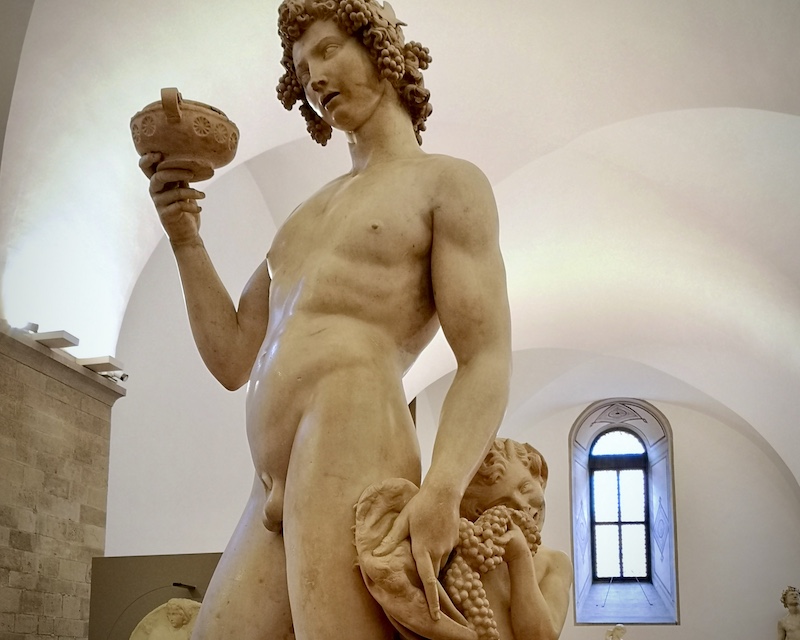
The Bargello is Florence’s premier museum dedicated to Renaissance sculpture, and so it’s no surprise that a number of Michelangelo specials light up the collection. Housed in an imposing medieval palace that was originally built as a fortress, the most famous Michelangelo sculpture on show here is the Drunken Bacchus, which features the ancient god of wine leering drunkenly with a goblet of hooch in his hand. Trailing along behind is a youth twirling bunches of grapes about his fingers.
The Bacchus was the first commission that Michelangelo received in Rome; although it was too bawdy for the powerful patron Cardinal Raffaele Riario, the sculpture nonetheless enhanced the young artist’s reputation and was soon snapped up by the Medici back in Florence.
Also at the Bargello are the Tondo Pitti, an unfinished round relief depicting the Virgin and Child that Michelangelo was forced to abandon when he again left Florence for Rome in 1504, and a faux-antique portrait bust of Brutus, the assassin of Julius Caesar who was seen as a heroic defender of liberty by republican Florentines. Finally, look out for the Apollo-David, an unfinished work whose subject has divided critics - some think he’s the biblical hero David, others the ancient god Apollo.
7. The Church of Santo Spirito
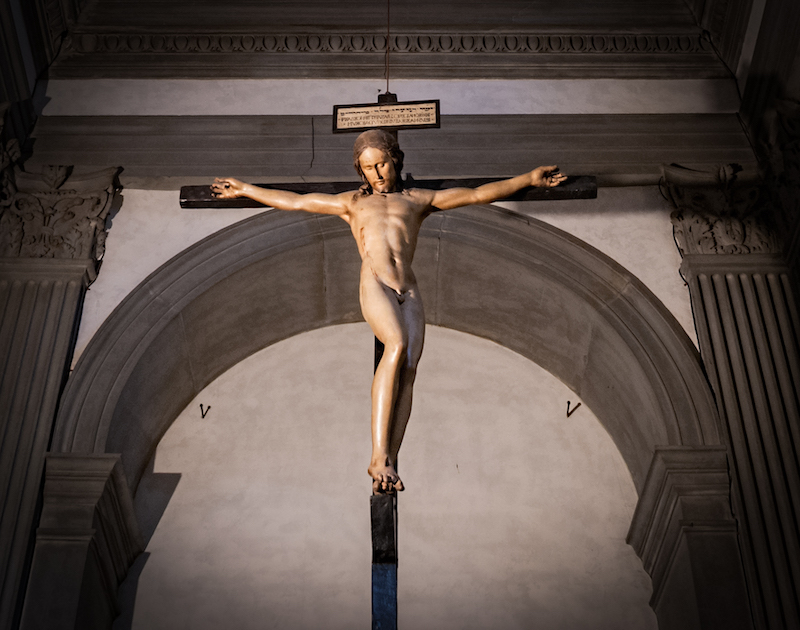
Photo Gary Campbell-Hall, wikimedia commons, CC BY 2.0
Michelangelo’s lifelong interest in anatomy and his incredible skills at rendering the human body were honed in a surprising place: the hospital adjoining the church of Santo Spirito just south of the river Arno.
Michelangelo stayed in the monastery after the death of his patron Lorenzo de Medici in 1492. Keen to nurture his talent, the prior in charge allowed the young artist to visit the hospital at night, where he spent his time dissecting the dead bodies awaiting burial in the morgue.
This gruesome work was to prove fundamental for the evolution of Michelangelo’s art, and to thank the churchmen for their help he carved a wooden crucifix for the basilica. You can see the elegant and understated work, which features a nude Christ, without even a loincloth protecting his modesty, in a chapel just off the church sacristy.
8. Casa Buonarroti
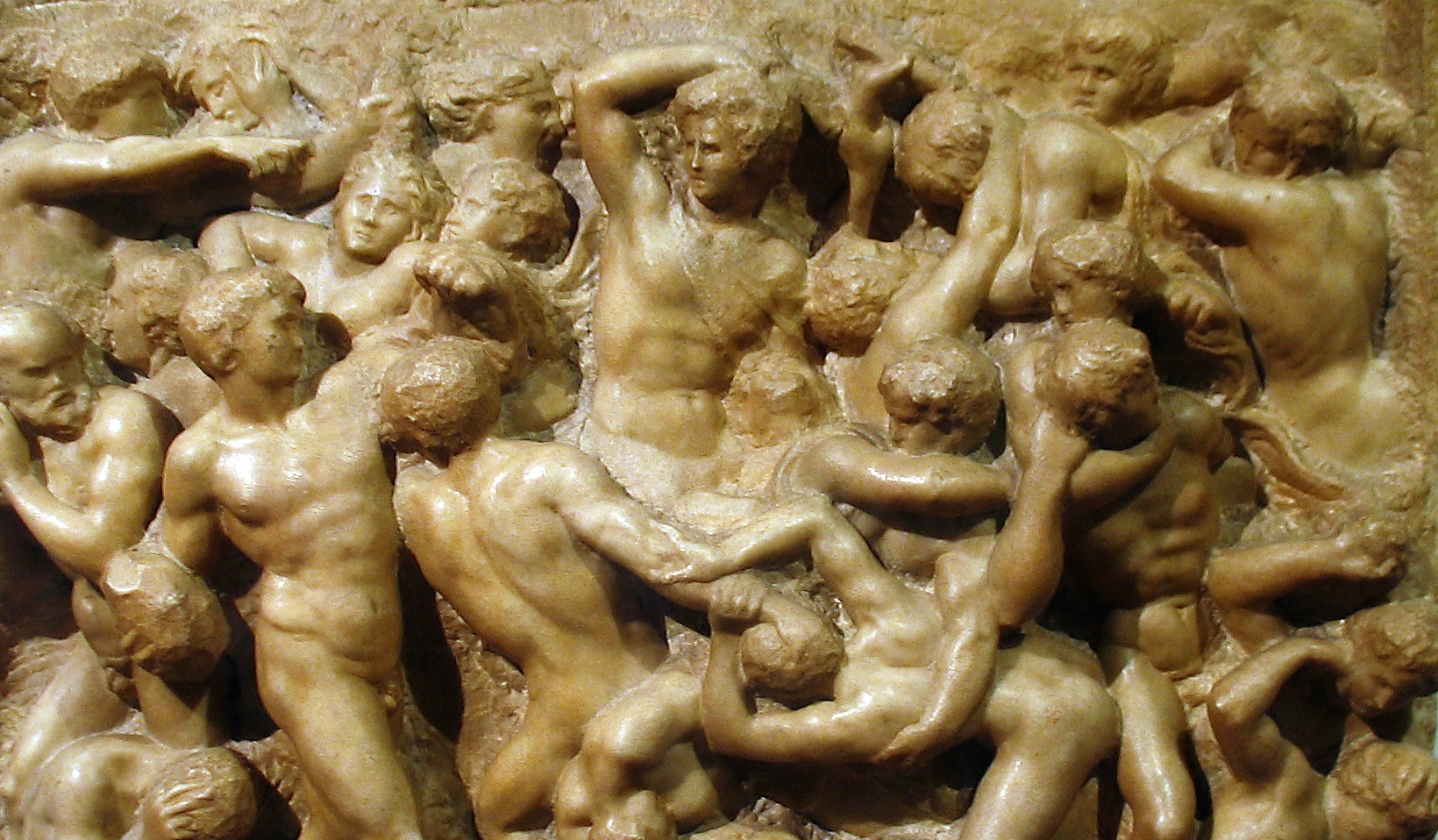
Dedicated to all things Michelangelo and founded by descendents of the great artist, the small but jam-packed Casa Buonarroti features two important early works by the master’s hand.
The Battle of the Centaurs is the earliest complex work known to be by Michelangelo, and features Greek warriors engaged in battle with mythological centaurs in a chaotic and crowded composition that owes much to the style of ancient Roman sarcophagi. Although he was barely 17 when he made this sculpture, we can already see Michelangelo’s strong interest in human anatomy in the twisting tangle of muscular nude figures.
The other major work in the Casa Buonarroti is the Madonna of the Steps. Carved in a type of very low relief known as rilievo schiacciato (literally ‘squashed relief’), a technique that Michelangelo adopted from Donatello, the sculpture features the Virgin and Child lounging on a set of stairs. Look out for the particularly fine drapery covering the classically-inspired Virgin.
9. The Laurentian Library in San Lorenzo

After sculpture and painting, the third major string to Michelangelo’s artistic bow was architecture. You’re probably aware that Michelangelo designed the dome of St. Peter’s basilica in Rome, but for many architectural historians it’s his work in the Florence church of San Lorenzo that ranks as his highest achievement in the field.
After Giulio de Medici became Pope Clement VII in 1524, he tasked Michelangelo with constructing a new library in the cloister of the church to house the family’s impressive manuscript collection. Various disasters, including the Sack of Rome in 1527, the death of the Pope and Michelangelo’s permanent exile to Rome meant that the Laurentian Library was only completed 30 years later in 1559.
What Michelangelo finally came up with, however, was startling: in the billowing, rippling stairway that leads up to the reading room he moved beyond the classical tenets of Renaissance design and created something much more playful, strange and alive. As ever ahead of his time, Michelangelo had laid the foundations for Baroque architecture decades before anyone else.
10. The Church of Santa Croce
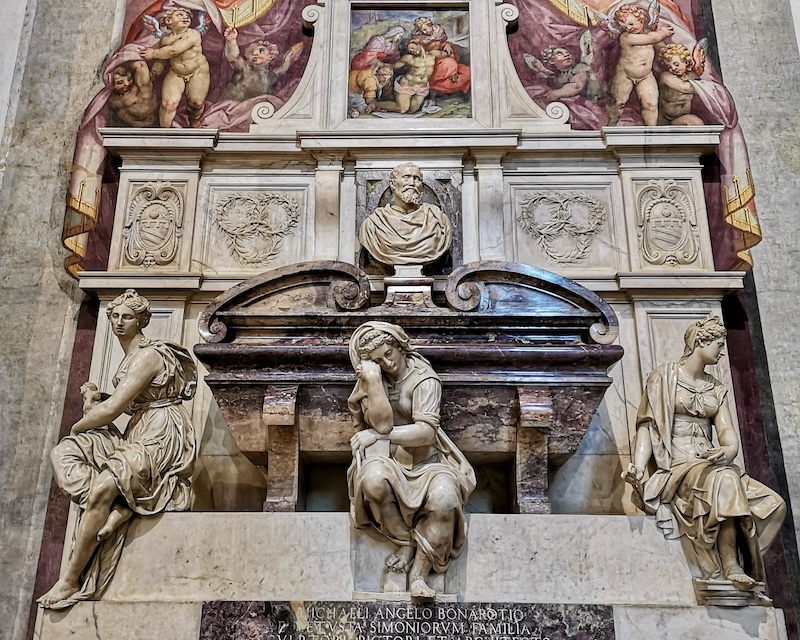
All stories have a beginning - and an end. The final chapter of Michelangelo’s story in Florence takes us to the sprawling church of Santa Croce, where the greatest artist the city had ever seen enjoys his eternal repose. Michelangelo, however, didn’t die in Florence.
In fact, he hadn’t set foot in his home city for fully 30 years when he finally went to meet his maker at his home in Rome in 1564 at the prodigious age of 88.
Stricken with grief at the death of the city’s most famous son, and horrified with the idea that he would be buried in faraway Rome, Florentines under the guidance of Duke Cosimo de Medici resolved to spirit away Michelangelo’s body back to his home city.
His corpse was successfully smuggled out of Rome by a group of merchants including his nephew Lionardo in a bale of hay. News of the audacious plan preceded the group to Florence, where they arrived to a hero’s welcome.
Michelangelo was finally and permanently laid to rest in the church of Santa Croce, alongside some of the greatest Florentines to have ever lived, in a grand tomb designed by his friend and biographer Giorgio Vasari. Paying our respects to the master, it's a fitting place to end our tour of Michelangelo’s art in Florence.
We hope you enjoyed our guide to where to see Michelangelo in Florence! If you’d like to visit the places described in this article, Through Eternity offer small group and private itineraries to the best sites in Florence led by art historians. To see the full range of our tours in Florence, or to arrange a customized itinerary to suit your interests, check out our Florence Tours page here.
MORE GREAT CONTENT FROM THE BLOG:
- What to See in the Accademia Gallery
- On the Trail of the Medici in Florence
- The Best Museums in Florence
- What to See in the Uffizi Gallery
- 7 Churches in Florence You Need to Visit
- The Most Beautiful Piazzas in Florence
